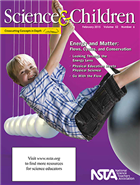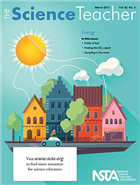NSTA’s K–College Science Education Journals: March 2015 Issues Online
By Lauren Jonas, NSTA Assistant Executive Director
Posted on 2015-03-11
Do STEM courses broaden access to science? Do you know how to use energy as a unifying theme that connects sciences, technology, engineering, and mathematics? The March K–College journals from the National Science Teachers Association (NSTA) have the answers you need. Written by science teachers for science teachers, these peer-reviewed journals are targeted to your teaching level and are packed with lesson plans, expert advice, and ideas for using whatever time/space you have available. Browse the March issues; they are online (see below), in members’ mailboxes, and ready to inspire teachers!
 Science and Children
Science and Children
Every science discipline provides excellent opportunities to connect with the crosscutting concept of Structure and Function. This issue of S&C offers ideas for introducing and developing this crosscutting concept in your classroom.
Featured articles (please note, only those marked “free” are available to nonmembers without a fee):
- Blade Structure and Wind Turbine Function
- Bringing Your Classroom to Life
- Free – Editor’s Note: Structure and Function
- Inventing Mystery Machines
- Free – Inviting Engineering Into the Science Lab
- Our Garden Plot Thickens
- Free – Outstanding Science Trade Books for Students K–12
- Full Table of Contents
 Science Scope
Science Scope
Engineering inspired by nature is just one approach you can use to incorporate the NGSS crosscutting concept of Structure and Function into your science curriculum. In this issue, we present several strategies for embedding crosscutting concepts and demonstrating to students how different science subjects are interconnected.
Featured articles (please note, only those marked “free” are available to nonmembers without a fee):
- Free – Biomimicry: The “Natural” Intersection of Biology and Engineering
- Bringing Historical Scientific Arguments Back to Life: The Case of Continental Drift
- Free – Editor’s Roundtable: Crosscutting Concepts: The Ties That Bind
- For the Love of Infographics
- Outstanding Science Trade Books for Students K–12
- The Surprising Patterns of Health and Disease
- Understanding the Art in Science and the Science in Art Through Crosscutting Concepts
- Why Theories Do Not Turn Into Laws
- Full Table of Contents
 The Science Teacher
The Science Teacher
The concept of energy is central to all the sciences. A clear understanding of energy is essential for life science students, especially in topics like photosynthesis, cellular respiration, ecosystems, and cellular transport. Energy transformations also are fundamental to understanding basic processes in chemistry and physics, from rusting cars and exploding dynamite to electric motors and wind turbines. In Earth and space sciences, energy drives climate, tectonic plate movements, volcanoes, earthquakes, and ocean currents. Perhaps more than any other single topic, energy provides a unifying theme that connects the sciences, technology, engineering, and mathematics in an authentic way.
Featured articles (please note, only those marked “free” are available to nonmembers without a fee):
- Free – Editor’s Corner: Exploring Energy
- Fields of Fuel
- Free – Finding the CO2 Culprit
- Our Town
- Free – Outstanding Science Trade Books for Students K–12
- Policy, Literacy, and Energy
- Sampling in the Snow
- Full Table of Contents
 Journal of College Science Teaching
Journal of College Science Teaching
Although there are many opportunities for undergraduates to participate in authentic research projects, little is known about the efficacy of such programs in achieving desired student learning outcomes. See Authentic Science Research Opportunities for a study that uses qualitative and quantitative data, surveys, and interviews to examine this issue. Do you use case studies in your teaching? If so, you may have wondered how to make those case studies part of your tests. Clyde F. Herreid provides some answers to this question in the Case Study column. And read about two cohort programs at a small liberal arts college designed to support the development of students from groups underrepresented in STEM fields in terms of their drive to succeed, their sense of belonging at college, and their learning in STEM courses in Broadening Access to Science.
Featured articles (please note, only those marked “free” are available to nonmembers without a fee):
- Authentic Science Research Opportunities: How Do Undergraduate Students Begin Integration Into a Science Community of Practice?
- Building the Impetus for Change: An Across-Curriculum Initiative in Biology
- Higher Education Faculty Collaboration With K–12 Teachers as a Professional Development Experience for Faculty
- Free – How College-Level Introductory Instruction Can Impact Student Epistemological Beliefs
- Research and Teaching: Broadening Access to Science With Support for the Whole Student in a Residential Liberal Arts College Environment
- Research and Teaching: The Roles of Mentoring and Motivation in Student Teaching Assistant Interactions and in Improving Experience in First-Year Biology Laboratory Classes
- Research and Teaching: Toward Interdisciplinary Perspectives: Using Osmotic Pressure as an Example for Analyzing Textbook Explanations
- Usefulness of Livescribe Web Recordings as Supplemental Resources for a Large Lecture Undergraduate Course
- Writing Stories in the Sciences
- Full Table of Contents
Get these journals in your mailbox as well as your inbox—become an NSTA member!
The mission of NSTA is to promote excellence and innovation in science teaching and learning for all.
Follow NSTA
Disclaimer: The views expressed in this blog post are those of the author(s) and do not necessarily reflect the official position of the National Science Teaching Association (NSTA).


